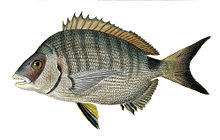Sargo
| Sargo | |
|---|---|
 |
|
 |
|
| Scientific classification | |
| Kingdom: | Animalia |
| Phylum: | Chordata |
| Class: | Actinopterygii |
| Order: | Perciformes |
| Family: | Sparidae |
| Genus: | Diplodus |
| Species: | D. sargus |
| Binomial name | |
|
Diplodus sargus Linnaeus, 1758 |
|
 |
|
| Synonyms | |
|
Sargus rondelettii Valenciennes, 1830 |
|
Sargus rondelettii Valenciennes, 1830
Sargus vetula Valenciennes 1830
Sargus sargus Cadenat, 1951
Diplodus sargus, called white seabream and sargo, is a species of seabream native to the eastern Atlantic and western Indian Oceans. It is found from the Bay of Biscay southwards to South Africa, including Madeira and the Canary Islands, the Mediterranean and (rarely) the Black Sea. Occasionally individuals are found off the Indian Ocean coasts of South Africa, Mozambique and Madagascar, and they are very rarely found elsewhere in the Indian Ocean, such as off Oman. An active fish, they inhabit the surf zone, but they may be found down to 50 m.
They consume small crustaceans, mollusks and some seaweed and coral, using their strong jaws to crush shells. Individuals can reach 45 cm, but average 22 cm.
Diplodus sargus are protandrous hermaphrodites, with individuals starting out life as males, and some becoming female later on.
It is commercially fished, with 3,713 t taken in 2008. Some are reared using aquacultural techniques. The catch is eaten immediately or marketed locally, as the flesh tastes good only when fresh.
Two US Navy submarines were named for this nimble fish, USS Sargo (SS-188) and USS Sargo (SSN-583).
The species has seven good subspecies, which are found in particular locales:
...
Wikipedia
